![]()
![]()
![]()
Use LEFT and RIGHT arrow keys to navigate between flashcards;
Use UP and DOWN arrow keys to flip the card;
H to show hint;
A reads text to speech;
35 Cards in this Set
- Front
- Back
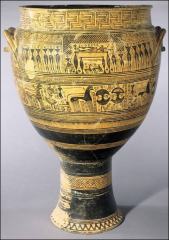
|
TItle: Geometric Krater
Artist: n/a Location: Athens, Greece Period of Art: Geometric Materials: ceramic 740 BCE. From the Dipylon cemetery. Decorations on the pot: shows a funeral procession, the human figures are stick figures, everything is very stylized. Registers are seen filed with abstract designs or scenes. |
|
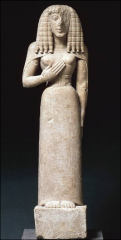
|
Title: Lady of Auxerre
Artist: n/a Location: Period of Art: Orientalizing Materials: Limestone 650-625 BCE. Daedalic style (frontal pose, flat figure, low forehead, large eyes & nose, flat skull, stance, triangular top head. Her hair is in vertical strands with horizontal lace (gives the neck stability). Small belted waist) |
|

|
Title: Kouros
Artist: n/a Location: Period of Art: Archaic Materials: Marble 600 BCE. Daedalic style seen in the coils of the hair and large eyes. Stylized hair and eye, anatomy inaccurate. Nude. Approx 6’ ½”. Egyptian influence. Grave marker. |
|

|
Title: Peplos Kore
Artist: n/a Location: Athens, Greece Period of Art: Archaic Materials: Chiton 530 BCE. Encaustic painting. Free-standing. |
|

|
Title: The Temple of Hera I
Artist: n/a Location: Pasteum, Italy Period of Art: Archaic Materials: Papyrus engaged column. Doric style temple. Peri style temple because the columns go all the way around. The Greeks worshiped on the outside. Only the priests entered the temple. Entasis= swelling of the column. The columns bulge out. |
|
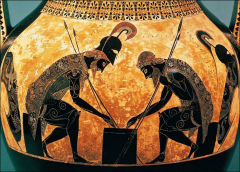
|
Title: Achilles and Ajax playing a dice game
Artist: Exekias Location: Vulci, Italy Period of Art: Archaic Materials: Black figure style. 540-530 BCE |
|
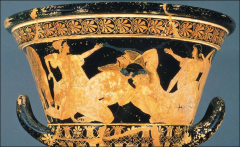
|
Title: Herakles wrestling Antaios (detail of an Attic red-figure caly krater)
Artist: Euphronios Location: Cerveteri, Italy Period of Art: Archaic Materials: Red figure style. 510 BCE. The red figures allow the artist to be more fluid with their figures. New positions of the figures. Ex: the leg of the giant is not fully seen. |
|

|
Title: Kritios Boy
Artist: n/a Location: Athens, Greece Period of Art: Classical Materials: Marble 480 BCE. approx. 2’ 10” high. Final break with Egyptian style. Transitional piece from Archaic to Classic. Contrapposto=counterbalance. More naturalism in the piece. |
|
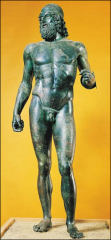
|
Title: Warrior
Artist: n/a Location: Riace, Italy Period of Art: Classical Materials: Bronze Bronze casting in the lost wax method – cire perdue. 460-450 BCE. 6’ 6”. Found in a shipwreck. |
|
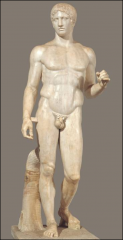
|
Title: Doryphoros (Spear Bearer)
Artist: n/a Location: Pompeii, Italy Period of Art: Classical Materials: marble. Roman marble copy after bronze original ca. 450-440 BCE. 6’ 6” high. The Kanon – symmetria, was a canon of ideal proportion. Chiastic pose= (Greek term) tense and flexed stand, cross diagonal to create balance in the piece. Contrapposto. Naturalism in the face, body, anatomy is correct. It’s a 1/7th proportion to the figure. |
|
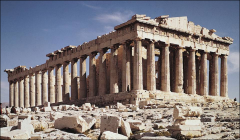
|
Title: Parthenon (Temple of Athena Parthenos) Iktinos and KALLIKRATES
Artist: n/a Location: Athens, Greece Period of Art: Classical Materials: 447-438 BCE. Peri style (columns all around). Doric order. Has ionic elements such as the continuous frieze on the inside. Proportion of Golden ratio. Has optical illusions: The columns lean inward a little bit and you cannot see the other ends when looking at the steps to make it appear straight so that it looks more perfect with harmony than it would be. Proportion is 7 to 1. |
|

|
Title: Three goddesses (Hestia, Dione, and Aphrodite) from the east pediment of the Parthenon
Artist: n/a Location: Athens, Greece Period of Art: Classical Materials: marble greatest height 4’5”. Hestia is looking to see Athena’s birth bc it is Parthenon. The figures are monumental. They have wet drappery bc it’s clinging to show the body underneath. |
|
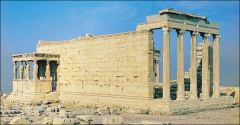
|
Title: Erechtheion
Artist: n/a Location: Athens, Greece Period of Art: Classical Materials: 421-405 BCE. Shrines - wooden image of Athena, Athena’s olive tree, Poseidon’s trident mark. Has an ionic porch. It’s not equal in elevation. The women holding the temples are referred to as Erechtheion. |
|
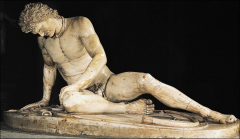
|
Title: Epigonos (?) Dying Gaul
Artist: n/a Location: Pergamon, Turkey Period of Art: Hellenistic Materials: ca. 230-220 BCE. approx. 3’ ½” high. He’s naturalistic but he’s not happy. He’s sitting on his shield. The lines in his face is tense and twisted to make him look uncomfortable. The Gaul is the enemy and he dies slowly. This shows that the greater the enemy the greater the victory. |
|
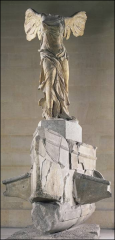
|
Title: Nike of Samothrace,
Artist: n/a Location: Samothrace, Greece Period of Art: Hellenistic Materials: marble 190 BCE. figure approx. 8’ 1” high. Nike=victory. She’s standing on a ship. Very dramatic. Incorporates all of the senses. Commemorated a naval victory over the Persian fleet. She has a wet drape, it’s theatrical. |
|

|
Title: Lacoon and his sons. ATHANADOROS, HAGESANDROS and POLYDOROS OF RHODES.
Artist: n/a Location: Rome, Italy Period of Art: Classical Materials: marble approx 7’ 10 ½” high. It’s a visual representation of a story. Greece becomes a Roman province. Lacoon was a Trojan king. Athena sent the snakes while they were offering sacrifice as punishment for his warning. Motion is created by the dynamic poses. Very dramatic. |
|
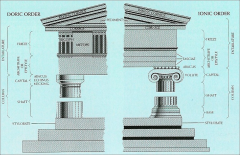
|
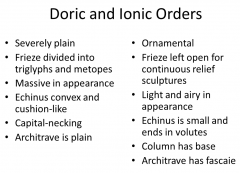
|
|
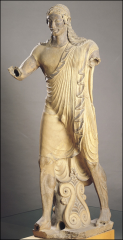
|
Title: Apulu
Artist: n/a Location: Veii, Italy Period of Art: Etruscan Materials: Painted terracotta. ca. 520 BCE. Approx 5’ 11” high. Roof of the Portonaccio Temple. Apulu= Apollo. |
|
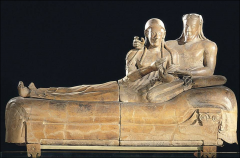
|
Title: Sarcophagus with reclining couple
Artist: n/a Location: Cerveteri, Italy Period of Art: Etruscan Materials: painted terracotta approx. 3’ 9 ½” x 6’ 7”. ca. 520 BCE. These figures are not as stiff and formal. The lower part of the leg isn’t shown well. The focus is on the upper body, which is more life-like. The faces and gestures are shown. It’s very natural and typical of Etruscan art. |
|
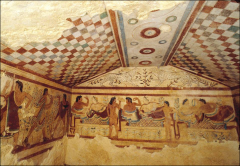
|
Title: Leopards, banqueters, and musicians, mural paintings, Tomb of the Leopards
Artist: n/a Location: Tarquinia, Italy Period of Art: Etruscan Materials: Fresco mural paintings ca 480-470 BCE. The deceased are banqueting with food and wine as in the real life. The woman are in lighter skin tone than men. Etruscan painters disregard anatomical movements. They bring the outdoors inside. |
|
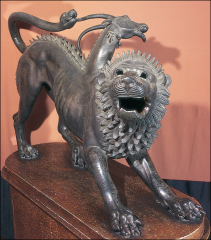
|
Title: Chimera of Arezzo
Artist: n/a Location: Arezzo, Italy Period of Art: Etruscan Materials: Bronze approx 2’ 7 ½” high. first half of 4th century BCE. The ribs and the veins add to the movement. |
|
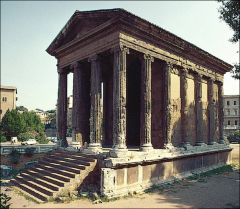
|
Title: Temple of “Fortuna Virilis” (Temple of Portunus)
Artist: n/a Location: Rome, Italy Period of Art: Republic Materials: ca. 75 BCE. Eclectic style-both Etruscan and Greek becomes the Roman design. Ionic Order. Engaged columns. Portunus – Roman god of Harbors. Fortuna Virilis= god of luck and chance. |
|
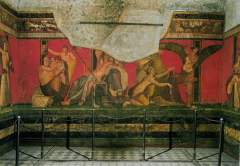
|
Title: Initiation rites of the cult of Bacchus (?), Villa of the Mysteries.
Artist: n/a Location: Pompeii, Italy Period of Art: Republic Materials: simulated marble dado, elegant frieze supported by painted pilaster strips. Dionysiac mystery frieze. Second Style wall paintings in Room 5 of the Villa of the Mysteries. ca. 60-50 BCE. Second Style - Illusionism and 3 dimensional. |
|
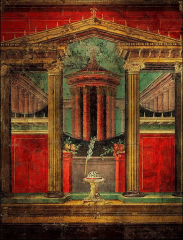
|
Title: Second Style wall paintings detail
Artist: n/a Location: Boscoreale, Italy Period of Art: Republic Materials: Second Style wall paintings detail, from Cubiculum M of the Villa of Publius Fannius Synistor. ca. 50-40 BCE, Painted doors and gate invite the viewer to walk in. Linear perspective (or look into the distance) created in Florence in Renaissance era. |
|
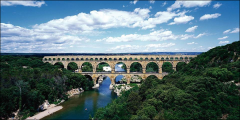
|
Title: Pont-du-Gard
Artist: n/a Location: Nimes, France Period of Art: Early Empire Materials: ca. 16 BCE. Roman aquaduct, brought water to Nimes, 100 gallons a day. Channels built with gradual decline helped the water flow. The upper most level carries the water. Why is the water able to run for 30 miles? Gravity is letting the water flow. Large arches span 82 feet. Each block weighs up to 2 tons. |
|

|
Title: Portrait of Augustus as general
Artist: n.a Location: Primaporta, Italy Period of Art: Early Empire Materials: marble early 1st century CE. Copy of a bronze original of ca. 20 BCE. 6’ 8” high. Augustine Classicism similar to Polykleitan style. Return of the Roman military standards from the Parthians. Cupid/Venus/Aeneas. There’s a smoothness to his skin and hair. Looks more human than god-like. He’s standing in contrapostal style. He looks young, handsome, athletic. |
|
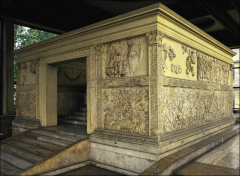
|
Title: Ara Pacis Augustae (Altar of Augustan Peace)
Artist: n/a Location: Rome, Italy Period of Art: Early Empire. 13-9 BCE Materials: marble 23’ high. Reconstruction by Mussolini – Fascist Era This celebrates Augustae’s peace. |
|
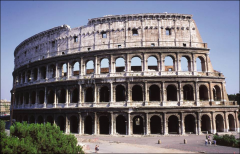
|
Title: Colosseum (Flavian Amphitheater)
Artist: n/a Location: Rome, Italy Period of Art: Early Empire. ca. 70-80 CE Materials: 160 feet tall. Originally it had marble seats. It’s a free-standing structure. 3 Orders Tuscan/Doric Ionic Corinthian Originally covered in marble. Has 76 exits. Stadiums today are based on this plan. |
|

|
Title: Pantheon
Artist: Location: Rome, Italy Period of Art: High Empire Materials: Temple to Mars, Venus, and Julius Caesar. Built by Marcus Agrippa. Corinthian columns |
|
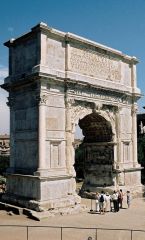
|
Title: Arch of Titus
Artist: n/a Location: Rome, Italy Period of Art: Early Empire; after 81 CE Materials: Built by Domition “Triumphal Arch” Conquests of Judea Engaged columns of composite type – Ionic and Corinthian. Deep relief carving and open space. |
|

|
Title: Column of Trajan
Artist: n/a Location: Rome, Italy Period of Art: High Empire; 112 CE Materials: Mausoleum Spiral: 625 ft Height: 128 ft 2500 Figures 150 episodes Two Military Campaigns against the Dacians. Original statue of nude emperor Trajan replaced with St. Peter. |
|
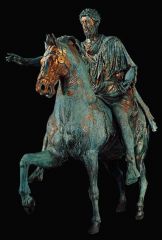
|
Title: Equestrian Statue of Marcus Aurelius
Artist: n/a Location: Rome, Italy Period of Art: High Empire; ca. 175 CE Materials: bronze Pope Paul III – 16th century, thought to be Constantine |
|
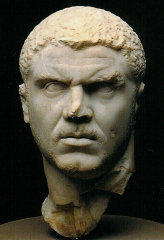
|
Title: Portrait of Caracalla
Artist: n/a Location: Period of Art: Late Empire; 211-217 CE Materials: marble approx 1’2” high. Suspicious. Murders Geta and wife Plantilla. Assassinated. |
|
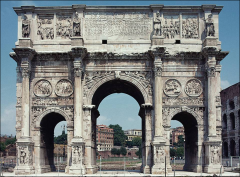
|
Title: Arch of Constantine
Artist: n/a Location: Rome, Italy Period of Art: Late Empire Materials: Celebrates the victory over Maxentius at the Milvian Bridge. Re-use of sculpture. Association with good emperors. Decline in creativity. Decline in technical skills. |
|
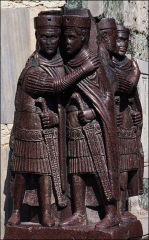
|
Title: Portrait of the four tetrarchs
Artist: n/a Location: Ca. 305 CE Period of Art: Late Empire Materials: Porphyry 4’3” high. Move away from classicism. |

